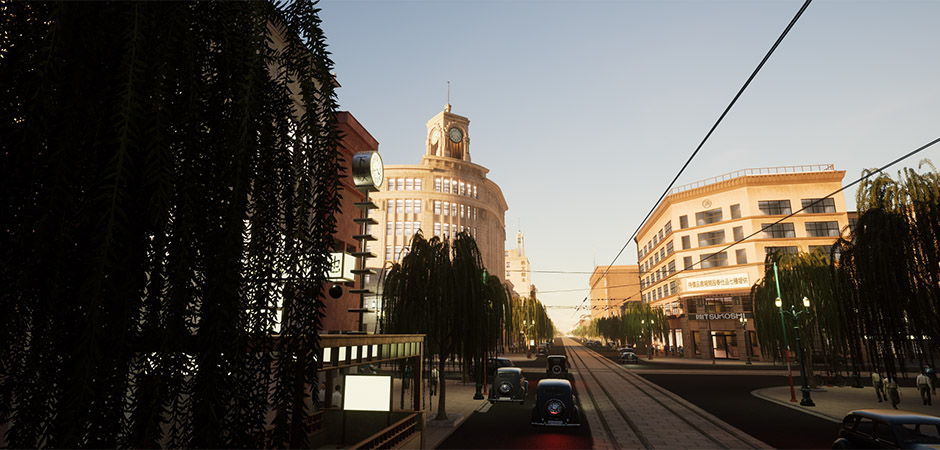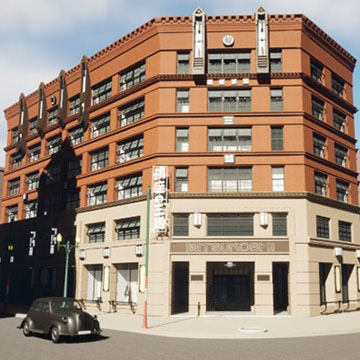The Tokyo Time Machine Project aims to create an immersive urban experience that feels as if one is truly time traveling. It does so by constructing an immersive virtual urban environment using innovative VR technology which is advancing every day. Another goal of this project is to seek out the possibilities of using VR technology to represent urban spaces.
As a first step, the three time periods of Edo (1850s), Meiji (1910s), and Showa (1940s) were established, centered around the Ginza 4-chome intersection in Tokyo's Chuo Ward. Endeavoring to recreate each era in VR as accurately as possible, research on each era's buildings, transportation infrastructure, attire, and other details was undertaken using maps, illustrations, photos, and historical records.
Latest updates
Mitsukoshi Ginza Store during the Showa period (around 1940)
The exterior and the ground floor of the Mitsukoshi Ginza Store from the Showa period (around 1940), were recreated with reference to materials from multiple stores of the early Showa period owned by Mitsukoshi Isetan Holdings Corporation. These materials include photographs, drawings, floor maps, and illustrations. Additionally, the layout represents a fictional arrangement of various product categories that were present in department stores during the early Showa period, consolidated on the ground floor.
Historical events around Ginza 4-chome intersection
From the Edo era through to the present, the target area of Ginza 4-chome intersection has undergone 3
large changes in form with the "Great Ginza Fire" in early Meiji, the "Great Kanto
Earthquake" in the Taisho era, and damage sustained during World War 2 in Showa.
The time periods just before each of these major change-inducing events--end of Edo (roughly 1850), end
of Meiji (roughly 1910), and the beginning of Showa before damage from the war (roughly 1940) were
selected for representation in VR in order to best reproduce how the area looked before it was altered.
| Year & Dates | Historical events |
|---|---|
| March 24th, 1608 | Ieyasu Tokugawa was appointed to be the new "Shogun", and the Shogunate (government) was established in Edo (current Tokyo). |
| 1612 | Ieyasu Tokugawa relocates the silver mint (silver coin factory) which was founded in Sunpu (current Shizuoka prefecture) to the current Ginza 2-chome location. In this period, an organization which produced silver coins was called "Ginza" and organizations which produced gold coins were called "Kinza". The area where this new silver mint was founded was hereinafter commonly called "Ginza". |
| The prosperity in Edo | After the foundation of "Ginza", the area became popular for many artisans, including
those associated with silver casting. Also, because this place was very close to
Nihonbashi, which was the starting point of the "Tokaido", many stores gathered, and the
area became very prosperous. Owari-cho (current Ginza 5-chome) was especially
prosperous, and had famous stores such as "Ebisuya", "Kameya", and "Hoteiya" which had a
similar scale and fame to the very famous "Mitsui-Echigoya". This area also gathered many talented people related to culture and art, such as "Noh actors" and "Geisha", as well as the "Kanoh School" artists. |
| 1800 | Due to the various fraudulent acts of "Ginza" officers, the Ginza silver mint was relocated to Kakigara-cho (current Nihonbashi-Ningyocho). After this move, the Ginza area became gradually obsolete. |
| October 23rd, 1868 | An imperial decree "Issei-ichigen-no-mikotonori", which determined the exisitng "Keio year 4" as "Meiji year 1" was issued, and the new period, "Meiji", begins. |
| April 3rd, 1872 |
The Great Ginza Fire A fire breaks out from the former Aizu daimyo spare residence (current outer garden of the imperial palace). This fire then spread and burned out Marunouchi, Tsukiji, and Ginza, all making up the central area of Tokyo. Due to this great fire, Tokyo-fu (Tokyo government) established a new urban plan called "Ginza Brick Town" which aimed to expand the streets and build fire resistent western style buildings using bricks as the primary material. |
| The prosperity in Meiji | The year when the "Ginza Brick Town" plan started,was also the year when Japan's first
railway was opened between Shinbashi and Yokohama. Since the Ginza area was located in
front of this new Shinbashi station, various western restaurants, bakeries, bag shops,
watch shops, and clothing shops which imported new goods and products from overseas had
gathered together. The Ginza area also attracted many newspaper and magazine companies, representing more than half of all newspaper companies which existed in Tokyo in the 1880's. By late Meiji, large scale retail stores called "Kankoh-ba" (similar to current department stores) has started to establish themsevles in the area. In this way Ginza attracted an increasing number of people to the area. |
| September 10th, 1923 |
The Great Kanto Earthquake A huge earthquake which caused enormous damage to Tokyo and Kanagawa as well as the surrounding prefectures occurred. The "Ginza Brick Town" was also destroyed, burning down because of this disaster. |
| The prosperity from Taisho to Showa | After the "Great Kanto Earthquake", Tokyo city (current Tokyo 23 wards) established a
reconstruction plan. Due to this plan, Ginza area's Harumi-dori was expanded, and a new
wide street called Showa-dori was created. Since the stores locatied on Ginza-dori were
very active in the restoration, the area was soon bustling again. During this restoration period, various department stores started to establish their presence in the area. In 1924 "Matsuzakaya" opened their store, followed by "Matsuya" in 1925, and "Mitsukoshi" in 1930. The "Wako Clock Tower" which is still recognized as a symbol in Ginza today, has opened in 1932. Due to the continuous openings of new department stores, Ginza successfully attracted new customers to the area, and the gross real estate rent price became the highest in Japan by 1929, exceeding Nihonbashi which had been the highest for a long time. |
| 1945 |
The damage sustained during World War 2 On January 27th, 1945, a United States' B-29 conducted a bombing raid over Hibiya, Yuraku-cho, and Ginza. This incident was later called the "Ginza Air Raid". One of the bombs fell near the Ginza 4-chome intersection, and destroyed the subway entrance, burning out several buildings including the "Kyukyodo" building which was located nearby. There were also several more air raids in March and May of the same year, eventualy causing the destruction of most of the Ginza area. |
| The restoration after the war, rapid economic growth, and transforming towards the present |
"Hattori Watch Store", and "Matsuya Department Store" were requisitioned by the United
States army after the war, but were returned to Japan in 1952, the year following the
"Treaty of Peace with Japan (Sept. 8th, 1951)". After this return, an earnest post war
restoration had begun. Rivers surrounding Ginza had been landfilled with war debris, and the main mode of transportation shifted from boats to cars. Due to the rapidly expanding subway systems, and traffic congestion in the streets of which they were a cause, trams were abolished by 1967. Up until then, they had been an important mode of transportation for the people in the area. After the trams were abolished, Ginza-dori had a great restoration, moving telegraph poles and cables from above ground to underground utility tunnels, and reusing paving stones originally used for the tram rails for pedestrian pathways. The "Pedestrian Paradise" which takes place on Ginza every Sunday and holiday today, was first implemented after this restoration in August, 1970. After the rapid economic growth period which took place from the 1950s to 1970s, Ginza experienced a deregulation of building codes in the late 1980s (the "Bubble Economy" period) which resulted in various redevelopment projects. This led to the current Ginza cityscape as we see it today. |
Bibliography
-
Edo era
-
-
江戸買物独案内, 中川五郎左衛門 編
-
江戸期の銀座, TOKYO GINZA OFFICIAL
-
江戸之下町復元図, 東京都中央区立京橋図書館
-
江戸住宅事情 都市紀要(34), 作者不詳
-
江戸と江戸城, 内藤昌
-
江戸の町 巨大都市の誕生, 内藤昌 穂積和夫
-
江戸名所尾張町之図, 一松斎芳宗
-
江戸名所図会, 鈴木棠三、朝倉治彦
-
熈代勝覧, 作者不詳
-
近世都市江戸町方の研究, 国立歴史民俗博物館研究報告第14集
-
慶長江戸絵図, 作者不詳
-
古今東京名所(恵比寿屋), 文化庁
-
古写真で見る江戸から東京へ, 小沢健志・鈴木理生
-
大区小区時代の沽券図, 東京都中央区立京橋図書館
-
東海道之内(御上洛東海道)江戸尾張町, 原書房
-
東京尾張町之図, 早稲田大学図書館
-
東京のれきし 道路・鉄道、まちづくり編, 双葉社スーパームック
-
東都尾張町繁栄之図, 原書房
-
日本史リブレット 町屋と町並み, 伊藤毅
-
幕末・明治の東京, 東京都写真美術館
-
復元日本大観「民家と街並み」, 稲垣榮三
-
武州豊嶋郡江戸庄図, 作者不詳
-
萬延元年江戸図, 作者不詳
-
-
Meiji era
-
-
沿革, 銀座 木村屋総本店
-
鳩居堂の歴史, 鳩居堂
-
銀座街づくりコラム, 銀座デザイン協議会
-
近代(明治~昭和初期)の服飾, KONJAKU REPORT
-
古写真で見る江戸から東京へ, 小沢健志・鈴木理生
-
サッポロライオン沿革, サッポロライオン
-
東京のれきし 道路・鉄道、まちづくり編, 双葉社スーパームック
-
内務省地理局 東京実測全図, 東京都中央区立京橋図書館
-
幕末・明治の東京, 東京都写真美術館
-
春風に舞う「銀座の柳」, 中央区観光協会特派員協会
-
明治・大正期の銀座, TOKYO GINZA OFFICIAL
-
明治17年 参謀本部陸軍部測量局 東京五千分一図, 東京都中央区立京橋図書館
-
明治の東京計画, 藤森照信
-
山野楽器の歩み, 銀座 山野楽器
-
よみがえる明治の東京 東京十五区写真集, 玉井哲雄・石黒敬章
-
-
Showa era
-
-
あの日の銀座, 佐藤 洋一・武揚堂編集部
-
伊勢丹新宿本店正面玄関改修工事, 三和タジマ株式会社
-
火災保険特殊地図(昭和7~11年、昭和20年代), 東京都中央区立京橋図書館
-
木村屋総本店沿革, 木村屋総本店
-
鳩居堂の歴史, 鳩居堂
-
京橋物語1~銀座から見える曲がり角, 中央区観光協会特派員ブログ
-
銀座駅出入口 交差点, メトロアーカイブアルバム
-
銀座支店 外観および店内画像・図面・絵葉書, 株式会社三越伊勢丹ホールディングス
-
銀座の柳, InfoAtlas =地図データベースの情報バインダー=
-
近代(明治~昭和初期)の服飾, KONJAKU REPORT
-
古写真で見る江戸から東京へ, 小沢健志・鈴木理生
-
サッポロライオン沿革, サッポロライオン
-
新宿支店フロアマップ(1930年), 株式会社三越伊勢丹ホールディングス
-
セイコーのあゆみ, セイコーミュージアム銀座
-
大東京寫眞案内(復刻版), 博文館編纂部
-
大三越歴史寫眞帖, 株式会社三越伊勢丹ホールディングス
-
東京銀座商店建築写真集 : 評入, 国立国会図書館デジタルコレクション
-
東京のれきし 道路・鉄道、まちづくり編, 双葉社スーパームック
-
日本近代建築の父 アントニン・レーモンドを知っていますか, 教文館
-
日本地理風俗大系 第二巻 大東京編, 仲麻照久
-
日本橋本店 店頭・ショーウィンドウ画像(1940~50年代), 株式会社三越伊勢丹ホールディングス
-
日本百貨店総覧(昭和8年), 株式会社三越伊勢丹ホールディングス
-
PR誌三越(銀座三越開店), 株式会社三越伊勢丹ホールディングス
-
山野楽器の歩み, 銀座 山野楽器
-
和光時計塔文字板のレプリカ, セイコーミュージアム銀座
-
Last updated:August 18th 2023
©2021 Mori Memorial Foundation & ZOAN JAPAN

